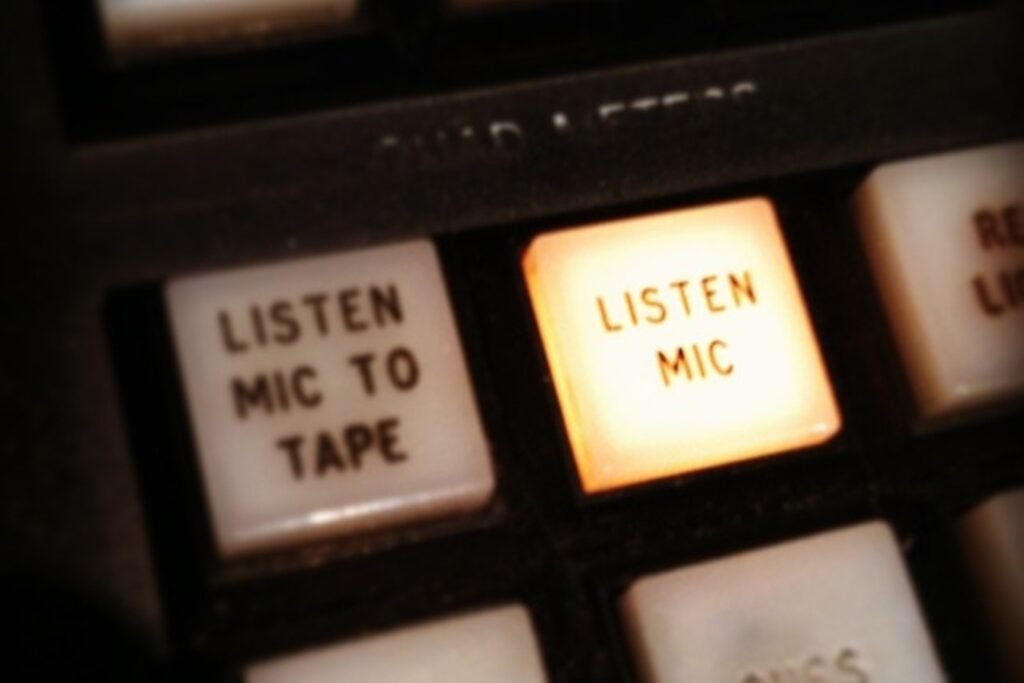
28 Nov Gear quirks and unexpected icons
Recording studio gear that’s misused, abused, or just downright thrown into the wrong situation, but, these adventurous mishaps have gone on to create some of the most iconic sounds ever captured.
Whether it be a broken guitar amp speaker helping create the distinctly distorted guitar sound of rock ‘n’ roll in the 1950s, or the use of Auto Tune in in the 2000s, sometimes it’s highlighting the quirks of particular equipment being used in the “wrong” way that truly inspires those creative moments in the recording studio.
We’re going to take a look at some special recording studio pieces of gear that accidentally inspired some of the most creative and iconic sounds ever captured. As the golden rule of engineering dictates, there are no rules.
Read all the latest features, columns and more here.
The SSL “Listen Mic” Limiter
It’s funny how things work out in the studio, when simply pressing a button on the console in order to talk to the drummer can literally change everything! Not to sound hyperbolic, but this little recording studio accident helped create one of the most iconic drum sounds ever recorded. That drum sound of course refers to, the Phil Collins drum sound.
In the early ’80s, the famed Townhouse Studios in London had just gotten hold of a brand spanking new SSL 4000 console, being only one of a couple available at the time. Aside from the brimming channel strips of this new beast, the SSL also had a couple of clever talkback paths, typically used for communication between the control room and live room; allowing the engineer/producer and artist to have open streams of communication without taking up valuable input channels.

To help alleviate potentially blowing up recording studio monitors, the listen mic’s audio path featured a very heavy handed limiter, drastically taming potentially destructive sounds coming from the live room when this channel was open. These limiters were indeed ruthless, holding no prisoners when it came to squashing audio. They sounded aggressive as hell!
During the tracking sessions for Peter Gabriel’s third studio album Melt, which Phil Collins was a guest drummer on, producer/engineer Huge Padgham pressed the listen mic button on the console to talk with Phil out in the live room. The drum sound he heard back when the channel was engaged was explosive, thunderous, and unlike anything heard before. Unfortunately, with the console in its default state, this channel path wasn’t able to be recorded, so Hugh requested the in-house tech to modify the console so that the listen mic path could be recorded separately and further processed with the channel strips gate and other processing, a new drum sound was born.
This then inspired Phil Collins to hire Hugh to record his debut album Face Value, wanting to get the same drum sound he got on Peter Gabriel’s album. This can famously be heard on the track ‘In The Air Tonight’. Who doesn’t love air drumming that initial drum fill, come on!
Tech 21 NYC SansAmp
Released in 1989, Tech 21’s SansAmp to many was yet another stompbox pitched at guitarists. Cool, like the ’80s needed more distortion pedals right? But upon walking into a Guitar Center (sic) and seeing the SamsAmp behind the counter upon a plastic plinth, Tchad Blake (pioneering recording and mix engineer) saw more than just an amp modelling pedal with some dip switches on the front, and thus, the SansAmp found itself being used in ways it did not intend.
Prominently used on the Los Lobos album Kiko, Tchad started using the SansAmps not on guitars ironically, but rather in the processing chain of the kick and snares drums, adding a characterful grit and thickness, creating a distinctive new sound to the drums, while still retaining the punch, clarity, and depth Tchad had become known for. The pedal and the Avid Pro Tools plugin has become so synonymous with Tchad’s body of work; you’d be hard pressed to find a recording or mix that he’s worked on that doesn’t feature a SansAmp, even if its tucked away deep in a session.
Of course, the SansAmp has certainly found its way onto many guitarists pedalboards in its numerous iterations and updates over the years, but in audio engineering circles, the pedal (and plugin) has been consistently used in so many other ways, the creativity and sounds of this one pedal has helped inspire is almost unmatched.
Universal Audio/Urei 1176 Limiting Amplifier: “All Buttons In” Mode
Now we’re looking at one of the most, if not the most iconic compressor/limiters of all time, but not for the reasons one might think.
There’s a surfeit amount of reasons why the 1176 is so revered but our Ten Greatest Compressors of All Time Part One and Part Two are where to go for that.
Since its inception in the 1960s, the 1176 has become so synonymous with recording and mixing that it’s nearly impossible to think of what music would sound without this prized studio workhorse. But like many pieces of pro audio gear, there’s one unusual feature that many would completely miss.
Like most compressors, the 1176 has several ratio settings to choose from with a near transparent 4:1, a slightly more assertive 8:1, and then 12:1 and 20:1 ratio’s for limiting. However, a rather illusive feature can be unmasked when all the ratio buttons are pressed at the same time, unleashing the “all buttons in mode”, or “Brit” mode. This dramatically changes the ratio, curve, and lag time of the attack of the compressor, thus changing how it reacts to and shapes transients and “crushes” signals going above its fixed threshold.
Distortion and harmonic artefacts are also a part of this unique mode and the effect is anything but subtle, instead having the capability to completely pulverise source material, but in such a satisfying way.
Often used in parallel to add character and power to a mix, the all buttons in mode is additional icing on an already very rich and delicious cake!
Antares Auto Tune
Quite possibly one of the most polarising musical tools ever created, Auto Tune at its inception was neither meant to be seen nor heard. Rather, it was initially intended to be an invisible tool, helping to cleverly mask or correct pitching issues; typically pitched at aiding recorded vocal performances, and later hardware units for live performances.
Introduced in the mid-late 1990s by Antares Audio Technologies, Auto Tune was first noticeably heard on Cher’s classic hit Believe, where the vocals in the chorus are noticeably pitch bent with the use of the software. From this point on, artists, producers, and mixers have become obsessed with how the software can be used, with numerous genres, styles, and indeed artists becoming synonymous with the software, notably artists such as T-Pain, Lil Wayne, Kanye West, and the Black Eyed Peas.
While Auto Tune has indeed received frequent denunciations from both artists and music critics alike, there are those who sing its praises. Many argue for its creative uses, its aid in creating new styles and forms of creative expression, rather than focusing on its negatives, which typically revolve around its ability to make anyone able to sing in pitch. Regardless of which side of the fence you sit, it’s hard to deny that from the moment Auto Tune was used in ways is wasn’t initially intended for, the flood gates of artistic expression opened, for better or worse.
Shure Level-Loc PA Limiter
Originally designed to help control the dynamics of the human voice while speaking into a microphone at a lectern, the Shure Level-Loc couldn’t have been more simplistic and unassuming. The almost comical selector switch on the front panel was meant to help determine the level of compression or limiting required dependent on how far away the speaker was from the microphone. The Level-Loc’s rather haphazard design didn’t exactly make for a great public address limiter in the end, but it did however, when put in the right hands, make for an incredibly creative audio tool, albeit for all the wrong reasons.
Tchad Blake once again flipped the engineering and mixing worlds on their respective heads with his rather unorthodox yet uniquely creative use of this simple piece of gear. His initial use of the Level-Loc on drums went on to inspire other engineers and musicians to create some of the most cacophonic, explosive, and crushing drum sounds to come out of the ’90s and ’00s, with the likes of Tom Waits, The Flaming Lips, and Tame Impala each getting a healthy sprinkle of the Shure Level-Loc’s distinctive bombastic magic!
There’s a lot to be said about the intended use of studio equipment, with the designers of such equipment likely wincing at how their beloved pieces have been misused by numerous individuals and in countless productions over decades of music creation. But when it boils down to it, exposing some the flaws, faults, or quirks of gear is what makes them so unique and desirable – making them the accidental icons they have become.
Head here for more from Tchad Blake.

